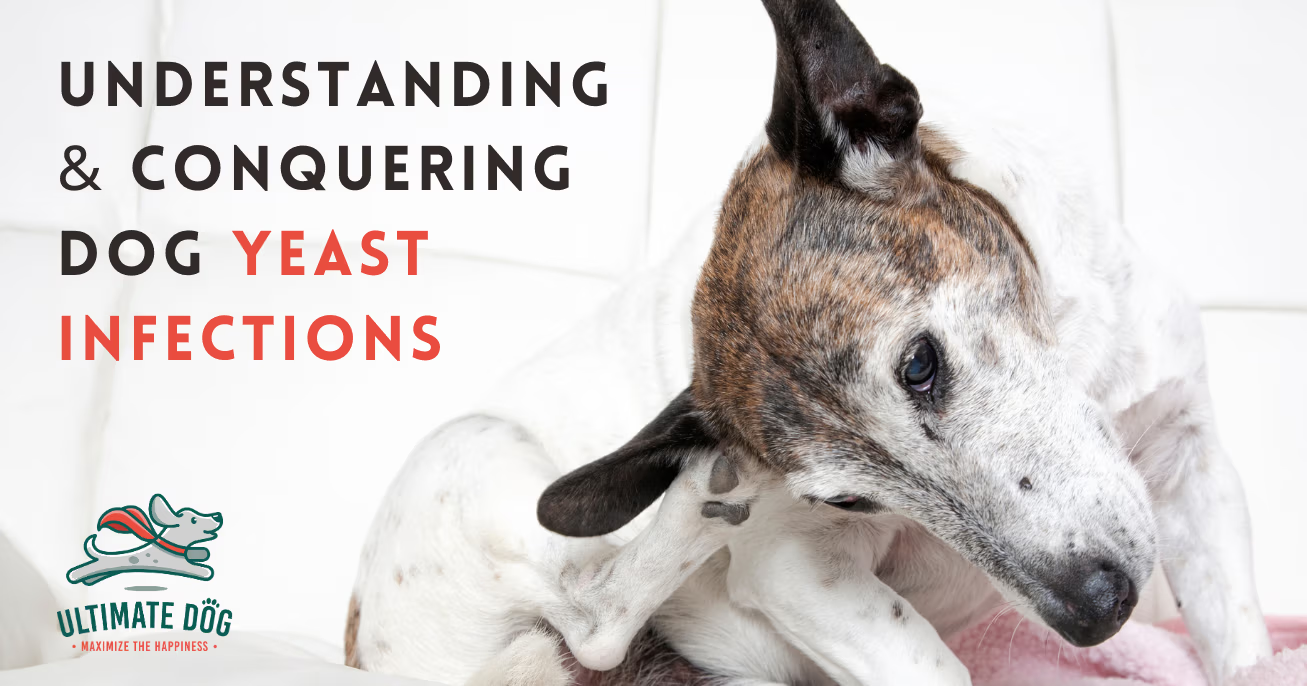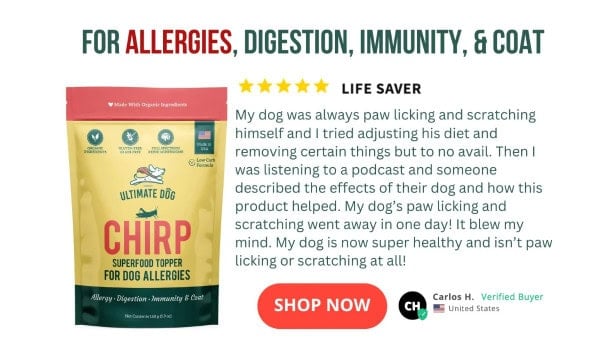Table of Contents
There’s one thing every human and dog on Earth share. No, I’m not talking about a natural bond that extends back fourteen thousand years to our early ancestors. I’m talking about candida.
This tiny, single-celled yeast lives inside (and outside) every adult human and dog on the planet. Under normal conditions, these little fungi are an important part of our diverse microbiome and help keep us healthy. But when things get out of whack, candida tends to take over, causing a host of symptoms that can be hard to manage and even harder to overcome.
In this article, we’ll look at the specifics behind yeast infections in dogs, what causes them, and the many symptoms that come with a dog candida infection. We’ll also tell you what you can do to help your dog restore balance to finally get rid of candida symptoms once and for all.
What Is Candida Albicans?
The most common type of yeast that exists inside us and our dogs is a single-celled fungus known as candida albicans. This yeast lives predominantly in the gut, mouth, nose, and throat, and in the genito-urinary system.
In healthy systems, candida albicans exist in balance with the trillions of other microorganisms that call the inside of your dog’s body home. But when things get out of balance, this yeast can quickly take over.
At first, this takeover is done through budding, a slow asexual reproductive process. But once numbers get high enough, candida begins to form mycelia, or long root-like structures that allow it to spread quickly and reproduce sexually—a much faster process.
Not only does candida albicans in this stage reproduce faster, but it also causes more damage. The mycelia it creates can penetrate the mucous membrane in the throat, intestines, and other organs. This is thought to be one of the leading causes of leaky gut syndrome, which causes a host of problems on its own, including food sensitivities, digestive upset, and lack of energy. Once candida gets to this point, it is also capable of getting into the bloodstream and spreading throughout the body.
While candida albicans is the most likely culprit for internal yeast overgrowth, it is not the only type of yeast your dog needs to worry about.
Malassezia pachydermatis is another common single-cell yeast that exists in the body’s biome. But this yeast lives predominantly on the skin. When Malassezia yeast experiences overgrowth, it results in symptoms such as ear infections, itchy skin, rashes, and skin thickening.
What Causes Yeast Overgrowth in Dogs?
Yeast infections, whether on the skin or in the body, occur when the natural balance of bacteria and yeast is thrown out of whack. There are a number of things that can cause this, including:
- Antibiotic use
- Certain medications, especially steroids
- Allergies
- Underlying health conditions, such as diabetes
- Poor diet
- Stress
- Weakened immune system
- Overvaccination
- Pesticides, including flea and tick medications
- Consuming meat that has been treated with antibiotics
- Mold
- Hot and humid environments
Most dogs in today’s world are exposed to not just one or two of these causes, but many of them at once. So it’s no wonder that so many of our furry friends experience candida overgrowth, or candidiasis, in their lifetime.
Dog Yeast Infection Symptoms
Because candida exists in so many different parts of the body and spreads so quickly, it causes a long list of symptoms that can seem unrelated.
Here are some of the most common canine candida symptoms:
- Chronic diarrhea
- Gassiness
- Inflammatory bowel disease
- Urinary tract infections
- Bladder and kidney infections
- Food sensitivities
- Food and environmental allergies
- Constant hunger
- Inability to gain weight
- Inability to lose weight
- Inflamed and itchy genitals and anus
- Lethargy
- Anxiety and hyperactivity
- Itchy skin
- Greasy fur
- Hot spots
- Thickening skin
- Rashes
- Ear infections
- Excessive odor and smelly paws
Unfortunately, the common treatments for many of these symptoms cause more harm than good.
Itchy skin, for instance, is often treated with steroids like Prednisone. However, Prednisone is known to cause candida overgrowth and microbe imbalance in the body. So, while symptomatic treatments might make one symptom better for a while, they are likely to cause new symptoms to pop up and worsen symptoms down the line.
How To Treat Candida In Dogs
Rather than focusing on symptomatic treatments, the key to defeating candida overgrowth is to treat what caused the overgrowth in the first place.
For many dogs, especially those who have been struggling with yeast overgrowth for a while, this will require addressing multiple issues. If your dog is on medications that are known to contribute to yeast overgrowth, for instance, now is the time to look for alternative treatments. And if your dog experiences a lot of stress, it’s time to find ways to reduce their stress by increasing their activity and adjusting their environment to promote calm.
While there are likely many things you’ll need to address to help your dog, there is one first step we recommend to all owners before they consider other dog yeast infection treatments, and that’s to take a hard look at your dog’s diet.
Change Their Diet
Dogs evolved to sustain themselves off of meat and fat. In fact, their closest living relatives, wolves, typically eat a diet that is 99% fat and protein. Only 1% of their calories come from carbohydrates.
This is quite a big difference from the average domestic dog. Typical commercial dry dog food is at least 65% carbohydrates. While our domesticated canines may be more capable of surviving off a high-carb diet than wolves, the yeast inside them will always appreciate this diet more.
Candida albicans maintains itself on a diet of sugar and starch. When your dog eats high-carbohydrate food, such as most kibble, it is consuming everything candida needs to thrive and reproduce. And because dog’s systems aren’t built to process that much starch, there is always plenty of leftovers to sustain a booming population of yeast.
This is why the first step to defeating dog candida overgrowth is to get your dog off high-carb food. The best way to do this is to switch them to a homemade or commercial raw meat diet.
These diets consist of raw meat and bone and a small amount of non-starchy fruits and vegetables. Because they are more biologically appropriate for dogs, they better support overall health. And, because they are very low in sugar and starch, they don’t feed yeast the way your typical dog food does.
Switching to a raw diet is the first step to defeating yeast, but you can take it a step further by ensuring the meat you use is organic. Non-organic meat is treated with antibiotics that can get into your dog’s system and continue to cause gut imbalances and candida problems.
Feed Probiotics and Enzymes
Changing your dog’s diet is a good first step, but they’ll need some extra help rebalancing their gut. This is where probiotic supplements and enzymes can be very useful.
Probiotics help reestablish beneficial bacteria in your dog’s system. These good microbes help crowd out yeast to keep their population in check.
One especially good probiotic to give dogs suffering from yeast overgrowth is Saccharomyces boulardii. This beneficial microbe is itself a type of yeast. But unlike candida albicans, it does not reproduce inside the body. And, more importantly, it naturally inhibits the growth of harmful yeast by preventing it from reproducing and by destroying the biofilm it creates to protect itself from immune cells.
As an added bonus, Saccharomyces boulardii is not affected by antibiotics, which means it continues working to restore balance even under conditions that would normally cause yeast overgrowth.
Enzymes are another important tool in the fight against yeast. These substances help break down compounds in your dog’s stomach and gut. When enzyme supplements are given on an empty stomach, they can help digest and kill off yeast growing in the digestive tract.
A quality supplement that contains both Saccharomyces boulardii and enzymes, such as CHIRP Superfood Topper, is a vital tool in treating dog yeast infections.
Use Natural Antifungal Supplements
Changing your dog’s diet and utilizing probiotics and enzymes to rebalance the gut are important steps to defeating candida. But they may not be enough to overcome this chronic affliction with any kind of speed.
One thing you can do to help hasten the process is to utilize some well-known antifungal herbs and supplements. Here are a few of our favorites:
- Oil of Oregano – This spicy oil contains carvacrol and thymol, two compounds with powerful antifungal effects (also a great natural flea and tick repellent!). Use as an oral supplement or topically to treat ear and skin infections. In either case, be sure to dilute the oil of oregano in a carrier, such as MCT oil.
- Pau d’arco – This herb from South America contains lapachol and naphthoquinones, both of which have been proven to kill yeast. Look for high-quality supplements that list the amount of lapachol in each capsule. Small dogs should take 100 mg per day, while extra-large dogs can take up to 500 mg.
- Caprylic Acid – This component of coconut oil has powerful anti-yeast properties. For best results, use MCT oil or a pure caprylic acid supplement rather than standard coconut oil, which can cause gut inflammation.
- Undecylenic Acid – This fatty acid is similar to caprylic acid but is derived from castor oil. It is a powerful antifungal that works both internally and topically to treat yeast infections.
- Thyme Oil – Thyme essential oil is another powerful natural oil that has been used for centuries to prevent mold growth in bread. And it works equally well to fight yeast overgrowth in the body (and another great natural flea and tick repellent!). It can be used topically or orally in dogs, just make sure to dilute it with MCT oil.
Maintaining Balance to Avoid Dog Yeast Infections
Because yeast is always present inside and on your dog, all it takes is one little thing knocking their system out of balance to cause yeast overgrowth. Because these overgrowths come with such a long and varied list of symptoms, it can be difficult to catch candida infections before they take over.
Luckily, it is possible to treat dog yeast infections and keep them from coming back. The key is to provide a biologically appropriate high protein and fat diet, avoid triggers like antibiotics, steroids, and pesticides, and utilize balancing supplements like probiotics, enzymes, and natural antifungals.
Once your dog is finally free of candida symptoms, you’ll need to continue to work hard to keep their gut biome balanced. This means being very selective about the food you feed and the medications you use. Using a long-term probiotic supplement, especially during times of stress and during antibiotic treatment, can also go a long way to preventing candida flair-ups in the future.
Sources
Jackson, J. A. Ph.D., BCLD, et al. Candida Albicans: The Hidden Infection. Chelation Medical Center.
Krasowska, A., Murzyn, A., Dyjankiewicz, A., Łukaszewicz, M., & Dziadkowiec, D. (2009). The antagonistic effect of Saccharomyces boulardiion Candida albicans filamentation, adhesion and biofilm formation. Fems Yeast Research, 9(8), 1312–1321.
Matsubara, V. H., Bandara, N., Mayer, M. P. A., & Samaranayake, L. (2016). Probiotics as antifungals in mucosal candidiasis. Clinical Infectious Diseases, 62(9), 1143–1153.
Wei, G., Xu, X., & Wu, C. D. (2011). In vitro synergism between berberine and miconazole against planktonic and biofilm Candida cultures. Archives of Oral Biology, 56(6), 565–572.
Zorić, N., Kopjar, N., Bobnjarić, I., Horvat, I., Tomić, S., & Kosalec, I. (2016). Antifungal Activity of Oleuropein against Candida albicans—The In Vitro Study. Molecules, 21(12), 1631.

Sara Seitz worked in the pet industry for over a decade. In addition to being a certified dog trainer, Sara gained experience working as the general manager of a dog daycare and boarding facility, as the creator and manager of a pet sitting company, as a groomer, and as a dog behavior evaluator. She also has a bachelors in animal behavior from CSU. Currently, Sara works as a freelance writer specializing in blog, article and content writing.




Leave a Comment